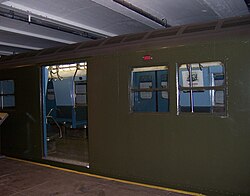R16 (New York City Subway car)
| R16 | |
|---|---|

An R16 car on display at the NYTM
|
|
| Manufacturer | American Car and Foundry, USA |
| Replaced | BMT Zephyr |
| Constructed | 1954-1955 |
| Entered service | 1955 |
| Scrapped | 1983 (6400-6499) 1987 (6300-6399) |
| Number built | 200 |
| Number preserved | 4 |
| Number scrapped | 196 |
| Formation | Single unit cars |
| Fleet numbers | 6300-6499 |
| Capacity | 70 (seated) |
| Operator(s) | New York City Subway |
| Specifications | |
| Car body construction | LAHT carbon steel |
| Car length | 60 ft (18.29 m) |
| Width | 10 ft (3.05 m) |
| Height | 12.08 ft (3.68 m) |
| Platform height | 3.76 ft (1.15 m) |
| Doors | 8 |
| Maximum speed | 55 mph (89 km/h) |
| Weight | GE cars (6400-6499) 84,532 lb (38,343 kg), WH cars (6300-6399) 86,270 lb (39,131 kg) |
| Traction system | Westinghouse 1447C; GE 1240A4 Westinghouse UPC631A; GE MCM 17KG113D1 |
| Power output | 100 hp (75 kW) / 4 per car |
| Acceleration | 2.5 mph/s (4.0 km/(h·s)) (?) |
| Braking system(s) | WABCO ME42 SMEE |
| Track gauge | 4 ft 8 1⁄2 in (1,435 mm) |
The R16 was a New York City Subway car built by American Car and Foundry Company from 1954 to 1955.
The R16s were numbered 6300–6499.
When delivered, the R16's quickly became the new standard in car design for the New York City Transit Authority. Structurally and mechanically, they were the larger versions of the R17s and yet basically an improved version of the R10s with same exact dimensions except that the R16's had electrically operated door motors while the R10s had pneumatic door engines. When they were new, the R16's could give the R10 some competition when it came to speed - both cars were mechanically similar with four 100 horsepower motors and a balancing speed of 55 MPH.
The R16s, like the older Arnines, R10s, and R11s, featured three sets of mid-carbody passenger windows on each side. One set contained an illuminated rollsign box in lieu of a second window. This sign box had three readings arranged vertically - the top two being the train's terminals, and the bottom being the route. This window and signbox pattern became standard for later cars until the R40s. The R16 would also be the last car class delivered with cross wise seating until the R44 order in 1972.
There were two versions of the R16: Westinghouse-powered cars (6300-6399) and General Electric-powered cars (6400-6499), the latter of which were delivered earlier. The General Electric-powered cars used forced air to cool the rheostatic resistors used for acceleration and dynamic braking. Unfortunately, the low voltage rotary converter (motor-generator) was used to provide the air and proved to be problematic as the enclosure tended to trap dirt and rain water within, leading to high failure rates. Meanwhile, the Westinghouse-powered cars had resistors mounted in the open for slip stream cooling as had been the traditional means; this setup was found to be more reliable, and was used until the R22 order. In theory, both types of R16s could be run together; however, in practice, this was found to be less than desirable. Later in their service lives, cars of all classes would be segregated by electrical running gear to provide better fleet reliability.
The R16s were delivered between 1954-1955 in a kale green paint scheme, and first placed into passenger service on January 10, 1955 on the BMT #15, (now J). Two cars were painted gold for a celebration in 1955.
...
Wikipedia
